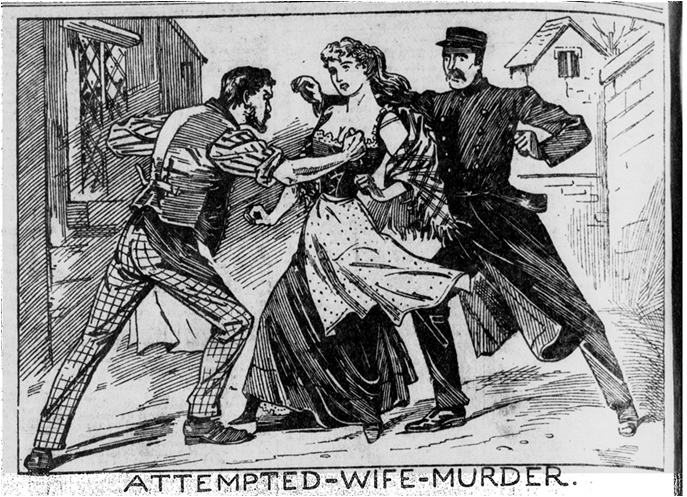The reverend William Ogborne was an unexpected occupant of a police court dock when he appeared before Mr Tyrwhitt in early January 1861. The self-declared Wesleyan minister pleaded not guilty to a charge of theft, even when it seemed perfectly clear that he had been caught red-handed.
Miss Alice Coker was taking tea at the Café Reche, Piccadilly in the early hours of Thursday 3 January, and had a small silver wreath with her, which she had placed on the table. At one point she called the waiter over and asked him to look after it for her while she left for a moment (perhaps to ‘powder her nose’).
When she returned and made ready to leave the café the wreath was gone. Looking around she noticed that the older man that had been sitting at a nearby table, dressed a like a cleric, had also vanished. Her suspicions fell on him instantly!
A policeman was called and, armed with a description, PC Luke Jeffery (49C) set off in pursuit. He quickly found Ogborne who was carrying a small rug under his arm, and asked him if he had seen the young lady’s wreath. He said he hadn’t.
PC Jeffery searched the rug but there was nothing there. He then asked Ogborne to remove his hat, which he did. And there it was, concealed inside!
The minister was arrested and he and Miss Coker attended Marlborough Street Police court later that morning.
In court Ogborne protested his innocence: he had overhead an altercation in the café between ‘some foreigners and others’, and he intervened to try and ‘throw oil on troubled waters’. There had been harsh words and ‘talk of swords and pistols’, and ‘a challenge’. In trying to defuse a potential duel he had accidentally knocked the small silver wreath into his hat and hadn’t noticed it as he set it upon his head and left.
The magistrate was surprised that a clergyman should be in such an establishment at 3 in the morning (which begs the question of what sort of young lady Miss Coker was to be there, tout seul, herself). He was equally confused as to why Ogborne had not admitted to having the wreath in his hat when the policeman had searched his rug. The minister simply said he’d gone in for some refreshment and as for the wreath, he had forgotten all about it.
Mr Trywhitt was probably quite conflicted; superficially here was a ‘respectable’ man (a Wesleyan minister) who swore he was innocent but had been found in very suspicious circumstances. Had Ogborne not been a religious person he would undoubtedly have been remanded while the theft was investigated. As it was the magistrate bailed him (set at £5) to reappear before him in a week’s time, and confiscated the wreath. Ogborne, who gave an address in St Albans (at Verulam Road, for those of you curious to know where) presumably left as quickly as he could.
A week later all the parties were back with the addition of a lawyer for Mr Ogborne (a Mr Lewis) and a new witness for the prosecution. PC Jeffrey presented a young woman (no name given, just an address in Pimlico – like Miss Coker) who confirmed the prosecution’s version of events. She agreed there had been an altercation as the minister described but said she saw Ogborne take the wreath while it was happening, and so benefitting from the distraction.
Mr Lewis told the court that there were a number of persons present – gentleman from St Albans – who would show that this was ‘one of those extraordinary circumstances in a man’s lifetime’.
The court must have been on tenterhooks…
Mr Tyrwitt was told that Ogborne had come to London to stay with a friend in Pimlico but had arrived to find there was no bed available. He headed to the Haymarket to find one (odd, since the Haymarket was associated with beds, but not ones you always slept in…). Having secured a birth for the night he went for refreshments.
This explained why he was in the café, his lawyer now explained the supposed theft.
During the mini-riot in the café he noticed the wreath and hid for safe keeping, aiming to return it to the young lady as the earliest opportunity. No one could doubt this, why would such a man steal such a trifle? He would happily produce 20 gentleman who would vouch for his client’s ‘irreproachable character’. He then proceeded to introduce a number of highly respectable members of St Albans ‘society’ (members of the corporation, a hat manufacturer, a clerk to the magistrates) all of who did exactly that.
Mr Tyrwitt agreed with Lewis that it was unlikely that any jury would convict a man of Ogborne’s ‘character’ and that character in this ‘was everything’. But he clearly had his doubts about him and probably suspected him of stealing the wreath, although there was no obvious motive. in the end he let him go with a warning to be more careful in future. I
t probably goes without saying to conclude that had William Ogborne been a member of the working class, and not able to find respectable character witnesses to excuse his behaviour, he would have either have sent him to face trial by jury or (and this is more likely given the disputed evidence) summarily sent him to prison for a month or so at hard labour.
Justice, as they say, isn’t always equal, or fair (then, or now).
[from Morning Chronicle Friday 4 January 1861; Morning Chronicle Friday 11 January 1861]









